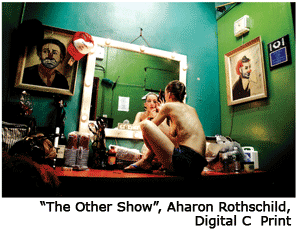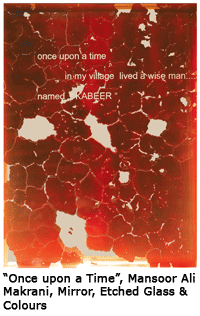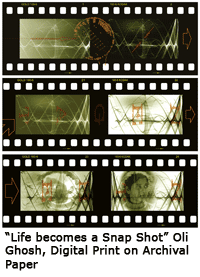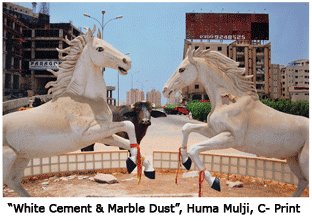- Prelude
- Guest Editor’s Column
- Hard Talk
- Eloquence of Silence
- The Age of Revivals: Gothic Revival Furniture
- Inkwell
- New Media : Living up to the chivalric code
- Universalizing Art through Individual Langue
- Speaking New Discourses
- Video Art of India- Gigi Scaria and his Videos
- Contemporary Trends of Sculpting
- In the News
- Artist Index and Statistics
- Market Insight
- Auction Reports
- The month that was
- Art Bengaluru
- Mumbai Artsighting
- Musings from Chennai
- Deccan Odyssey
- Delhi Dias
- In between – from Vadodara
- North-East Opsis
- A Tryst with Art in Madhya Pradesh
- Tradition and Beyond
- Reverie
- Indian (Sub) Way
- Creative Impulse
- Different hues of Aakriti
ART news & views
New Media : Living up to the chivalric code
Volume: 2 Issue No: 8 Month: 9 Year: 2010
 But the mere image of say, a computer or video cannot act in the same way with respect an advanced technological capability which is electronic rather then mechanical. These new gadgets are not simply the products of a particular society but are themselves the means by which that society reproduces itself. The form bears itself no relation to their content. It is only through the process of their functioning that they are able to represent the world, and when they do not function they are nothing. Time-based work is about something more than the reference of events to the passing moments, it is the involvement with a culture which can only be adequately be represented through these passing moments dwelling on the characters, messages, and vicissitudes of physical and emotional reality inherent in the very definition of real is; that of which it is possible to give an equivalent reproduction…the real is not only that which can be reproduced, but which is always already reproduced. That was the time of cable revolution when the Iraq war broke. The coverage of the war entered into our drawing rooms through TV's latest avatar the CNN-Fox. Above all it was a matter of the collapse of reality into hyperrealism, into a painstaking reduplication of the real war into any American war saga. In preference to starting out from some other medium,
But the mere image of say, a computer or video cannot act in the same way with respect an advanced technological capability which is electronic rather then mechanical. These new gadgets are not simply the products of a particular society but are themselves the means by which that society reproduces itself. The form bears itself no relation to their content. It is only through the process of their functioning that they are able to represent the world, and when they do not function they are nothing. Time-based work is about something more than the reference of events to the passing moments, it is the involvement with a culture which can only be adequately be represented through these passing moments dwelling on the characters, messages, and vicissitudes of physical and emotional reality inherent in the very definition of real is; that of which it is possible to give an equivalent reproduction…the real is not only that which can be reproduced, but which is always already reproduced. That was the time of cable revolution when the Iraq war broke. The coverage of the war entered into our drawing rooms through TV's latest avatar the CNN-Fox. Above all it was a matter of the collapse of reality into hyperrealism, into a painstaking reduplication of the real war into any American war saga. In preference to starting out from some other medium,  be it reproductive, publicity, photographic; from medium to medium the real war volatilized, it became an allegory of death, a new mega serial but it also reinforced itself by its own destruction, it became a proxy for the real, a fetishism of the lost object, no longer the object of representation, but an ecstasy of denial and of its own ritual extermination: the hyperreal.
be it reproductive, publicity, photographic; from medium to medium the real war volatilized, it became an allegory of death, a new mega serial but it also reinforced itself by its own destruction, it became a proxy for the real, a fetishism of the lost object, no longer the object of representation, but an ecstasy of denial and of its own ritual extermination: the hyperreal.Throughout these works there is challenge, both in its formal construction and in the themes these artists tackle. That of the artist's struggle with inhibitions, contradictions, disillusionment, political and personal isolation. Each new step, each new possibility retreats into old solutions and is discarded. But it would be impossible to stop- one has to create the text in spite of the odds. It confronts our traditional experience of sound, of light, of setting-these are wrenched out of context, re-ordered and returned to a new, subtle questioning role of reflecting the artist's choice of subject.
 Perhaps it is already time for a moratorium on things; a temporary withdrawal from real objects during which the object analogue formed in consciousness may be examined as the origin of a new generating system. A recurrent issue in the new media most often is the plight of the individual in a highly technological world. However, these works are ultimately optimistic although bristling with images of war, aggression, confrontation, displacement, there is a sense, achieved through ironic focus, that beyond lies something more hopeful but first it is necessary to overturn what we have and create the neutral space from which new things shall grow. A decade back artists began to combine image and text and over the last decade, these works have increased in subtlety and in the interplay of meanings. Today's new media artist opposes what he calls the old-fashioned “logocentric” Renaissance view of painting's “presence” with an art whose new apparatus include the notion of the institution and which uses today's primary means of communication, photography, video, cinema, television. The use of the despised medium, and a critique of the means of production led this practitioners to cast conceptual art as gesture not of denial but of opening up of the institution of art to the world outside, letting other disciplines.
Perhaps it is already time for a moratorium on things; a temporary withdrawal from real objects during which the object analogue formed in consciousness may be examined as the origin of a new generating system. A recurrent issue in the new media most often is the plight of the individual in a highly technological world. However, these works are ultimately optimistic although bristling with images of war, aggression, confrontation, displacement, there is a sense, achieved through ironic focus, that beyond lies something more hopeful but first it is necessary to overturn what we have and create the neutral space from which new things shall grow. A decade back artists began to combine image and text and over the last decade, these works have increased in subtlety and in the interplay of meanings. Today's new media artist opposes what he calls the old-fashioned “logocentric” Renaissance view of painting's “presence” with an art whose new apparatus include the notion of the institution and which uses today's primary means of communication, photography, video, cinema, television. The use of the despised medium, and a critique of the means of production led this practitioners to cast conceptual art as gesture not of denial but of opening up of the institution of art to the world outside, letting other disciplines.  These include linguistics, semiological analysis, political theory and above all psychoanalysis.
These include linguistics, semiological analysis, political theory and above all psychoanalysis. The signified and referent are now absorbed to the sole profit of the play of signifiers, of a generalized formalization where the code no longer refers back to any subjective or objective reality, but to its own logic. All reality then becomes the place of semiological manipulation, of a structural simulation. Remember the crowd gathered at the site of fire of the city's memorable building a few months back taking photo on their mobile phones to capture the spectacle of fire and death? They compete with each other with their priced acquisitions. Even the expensive cell phones never exhaust themselves in the function they serve, and in this excess of presence they take on their significance of prestige- they no longer designate the world but signify the social rank of the possessor. There is no objective presence to the world. The world is signed into existence not by reference to the real but to a code;
 at this point one is left to engage in acts of consumption which show is no longer really there. We expect the attempts/practices by with some memorable of images of our living and an artist's responses to simulacra.
at this point one is left to engage in acts of consumption which show is no longer really there. We expect the attempts/practices by with some memorable of images of our living and an artist's responses to simulacra.New media artists like Jashri Abhichandani or Aharon Rothschild have always seen their practice as an attempt to make changes in the perception of the social and cultural future through their interaction with the audience. These new media artists set out to create an artwork that will instigate in the audience perceptions, understandings of their own creative potential.
In Partha Guin or Mansoor Ali Makrani the logic of the process whereby the fixity of art object is challenged is seen in the increasing degree to which exchange value takes precedence over the use value. And if we take into consideration the knowledge, in the sense that art might provoke one to an understanding that a video monitor could provide us with must be characterized in Abhichandani's work more as information, the means to something other than the end in itself that is the performance.
 Art addresses the physiognomy of power: autonomy has ceased to operate as a paradigm because the space in which art functions has dispersed itself within the social fabric. There is no longer a separate realm capable of acting as a container for the ideal solutions to real problems, no longer a safe distance between the dirt of day to day actions and the purity which surrounds ones hopes and aspirations. The two spheres have merged into one complex hyperspace which is as yet incompletely mapped onto our consciousness…
Art addresses the physiognomy of power: autonomy has ceased to operate as a paradigm because the space in which art functions has dispersed itself within the social fabric. There is no longer a separate realm capable of acting as a container for the ideal solutions to real problems, no longer a safe distance between the dirt of day to day actions and the purity which surrounds ones hopes and aspirations. The two spheres have merged into one complex hyperspace which is as yet incompletely mapped onto our consciousness… Oli Ghosh is the analyst of her own identity. Neither Nantubehari Das, Huma Mulji , Sanhita Banerjee's aspirations are to make a meditated simulacrum of the politics of desire but to approach as near to the reality of that desire as possible, t
 o be in a complex and full way, realistic not ton be restricted by any debased modernism. There are many constants in these works, wherever its site or performance, those are indicative of their structural concerns and their expressive concerns. Its structure is made visible by lines and notational markings across a floor extending to the walls.
o be in a complex and full way, realistic not ton be restricted by any debased modernism. There are many constants in these works, wherever its site or performance, those are indicative of their structural concerns and their expressive concerns. Its structure is made visible by lines and notational markings across a floor extending to the walls. The legacy of time-base activity in contemporary practice which brings thoughtful and critical interest is to bear of cultural significance. It should bee seen in a positive light, though the confrontations have produced a body of serious work which offers a serious critique, and in case where it seems that content, treatment and the crucial question of narrative, that is process have retreated before an oppositional stance which centre soon production values alone, what is at first sight for example might appear as unwatchable can be seen on reflection as a refusal to succumb to the grand illusion.
Nanak Ganguly